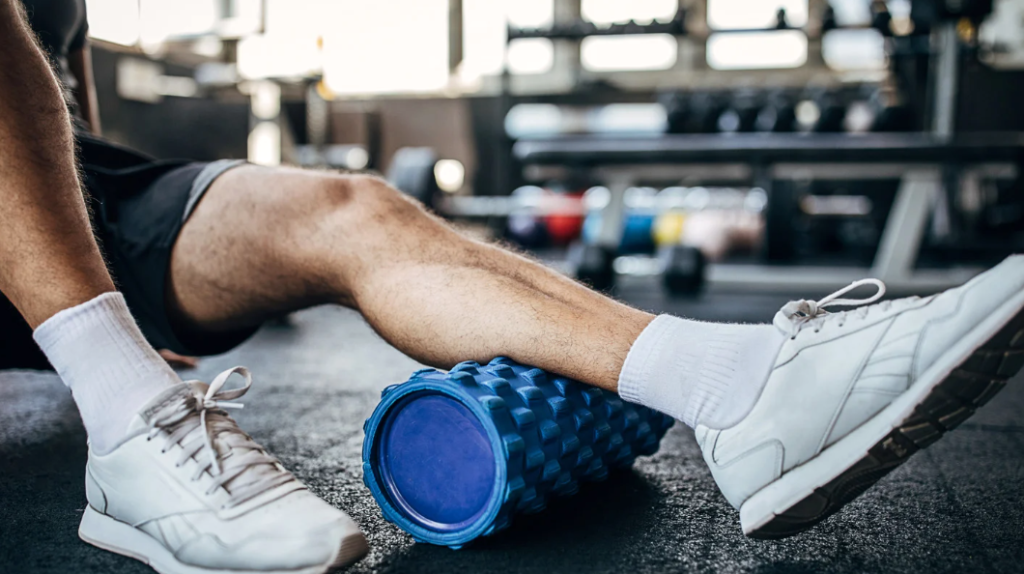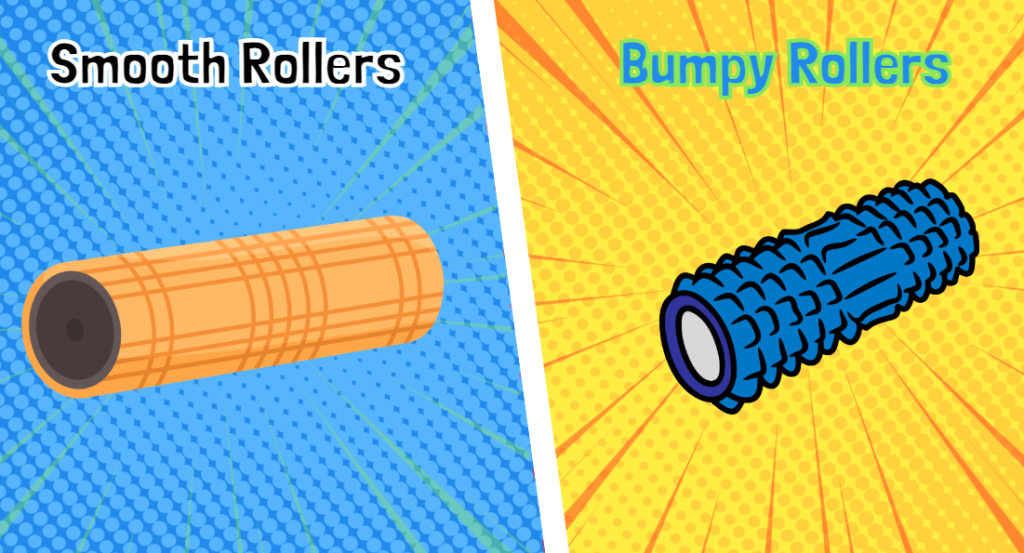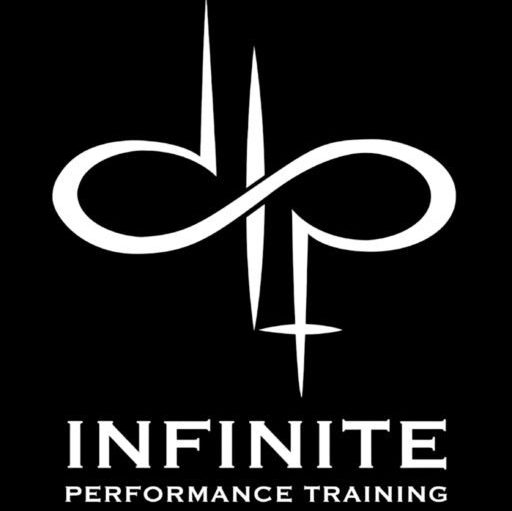Do you need foam rolling tips and/or want to learn more about foam rolling benefits?
This easy-to-follow guide reviews scientific insights that can reduce pain and speed recovery. This content will help you integrate foam rolling into your regular training routine to perform better and feel stronger. Our athletes and clients heavily rely on foam rolling to support our training routines and improve sports performance.
Let’s learn about the physical benefits of foam rolling and practical tips to implement for your routines!
Physical Benefits of Foam Rolling for Athletes
We rely on foam rolling to ease muscle soreness, boost flexibility, and speed up recovery. Joint support benefits those recovering from surgery by reducing adhesion risks. Evidence shows improved sleep and quicker recovery times help maintain muscle care and lower injury risks for peak athletic performance.
For most clients, we focus on the leg and hip to maintain a balanced approach to recovery and strength. Including foam rolling in our routines keeps your body in shape and promotes flexibility. Using targeted techniques to ease muscle tension and prepare for workouts is critical and great for warming up and cooling down sessions.
1. Alleviating Muscle Soreness
After my most rigorous workouts, foam rolling offers significant relief from muscle soreness while supporting faster recovery; I often check a trusted site for updated techniques and consult medical guidelines to ensure that my routine boosts performance and meets specific considerations relating to pregnancy and health insurance:
| Aspect | Detail |
|---|---|
| Muscle Soreness Relief | Helps reduce tension and discomfort after intense training |
| Performance Enhancement | Improves recovery speed for better training results |
| Medical Guidelines | Follows expert advice for safe use during pregnancy |
| Health Insurance Considerations | Ensures recovery methods align with recommended wellness practices |
2. Enhancing Flexibility and Range of Motion
I have noticed that foam rolling plays a vital role in boosting flexibility and range of motion during my exercise routine. I follow advice from the National Academy of Sports Medicine to ensure my tissue recovery supports improved endurance and the security of my body during intensive workouts. I find that incorporating these techniques keeps my muscles agile and resilient, which is essential for sustained athletic performance.
3. Promoting Faster Recovery Times
I have found that regular foam rolling sessions help reduce muscle fatigue and lower density within the skeletal muscle, speeding up recovery times after intense training. I use methods informed by trusted medicine resources to effectively target my muscle tension, ensuring that every session prepares me for the next workout. This practice relieves muscle soreness and supports overall muscle integrity and improved athletic performance.
4. Reducing Risk of Injury Through Improved Muscle Care
I use foam rolling to reduce injury risks by applying targeted tips that improve range of motion and support proper muscle care around key areas like the shoulder while maintaining healthy fascia and collagen levels for faster recovery:
- Focus on proper form during foam rolling sessions.
- Apply pressure gradually to target fascia and stimulate collagen repair.
- Incorporate dynamic movements that boost range of motion and shoulder stability.
GET IN TOUCH
Schedule a Training Session
Foam Rolling Techniques Specifically for Athletes

I use foam rolling to target key muscle groups, guide my training routine, and boost pre- and post-workout recovery. I share exercises designed for runners, techniques to ease calf tension while enhancing fiber strength, and breathing tips that support weight loss and overall fitness. This approach sets the stage for practical insights in each focused area.
1. Practical Foam Rolling Exercises for Key Muscle Groups
We integrate foam rolling into my routine by focusing on key muscle groups such as the elbow, knee, and ankle to boost joint stability and overall recovery, a method supported by Harvard research. I also employ techniques that activate my parasympathetic nervous system, which helps lower stress levels and supports a consistent training regimen.
2. Best Practices for Pre- And Post-Workout Foam Rolling
I use specific pre- and post-workout foam rolling techniques to manage friction and regulate weight distribution, which helps me prepare efficiently and recover effectively. I focus on key areas, including the gluteal muscles, to ensure that my sessions provide maximum benefits for athletes while I skip to content easily during busy training days:
- Warm up thoroughly before foam rolling
- Target the gluteal muscles for enhanced flexibility
- Apply controlled pressure to minimize friction
- Regulate weight distribution for balanced muscle engagement
- Finish with a gentle recovery session post-workout
The Mental and Emotional Benefits of Foam Rolling for Athletes
I use foam rolling as a practical tool to release muscle tension and address nerve pin issues in soft tissue. It helps me reduce stress, develop discipline with a steady routine, and improve my focus for a tighter mind-body connection. I break down each benefit in detail next.
Reducing Stress and Anxiety Through Self-Care
I have found that foam rolling plays a key role in reducing my stress and anxiety by easing persistent tension and softening stubborn knots in my muscles. I use a manual therapy approach to address connective tissue discomfort during my cooling down sessions, which helps me relax and stay focused after training.
Building Discipline and Routine With Consistent Use
I have discovered that staying committed to foam rolling not only builds discipline but also refines my workout routine, particularly as I focus on releasing hamstring tension, meeting both my fitness goals and insurance criteria. I rely on guidance from NASM and research such as PMC4299735 to maintain consistency and improve my training sessions:
| Aspect | Insight |
|---|---|
| Routine Consistency | Regular foam rolling strengthens discipline and sets the pace for effective workouts. |
| Muscle Care | Targeting the hamstring reduces tension, which supports better performance and recovery. |
| Informed Practice | Utilizing NASM guidelines and insights from PMC4299735 ensures safe and efficient training that aligns with insurance standards. |
Enhancing Focus and Mind-Body Connection
I use foam rolling to reduce lactic acid buildup and ease inflammation around my vertebral column, which helps me maintain strong focus during workouts. A relaxed mouth and regulated breathing support both my physical stability and my overall performance as an athlete.
Scientific Evidence Supporting Foam Rolling for Athletic Performance

Recent research shows that using a foam roller improves foot and quadriceps performance. I have reviewed studies on foam rolling’s effects and compared my experience with other recovery methods to support overall health. This section offers practical insights on how these findings can improve an athletic routine.
Reviewing Recent Studies on Foam Rolling Effects
I have examined several randomized controlled trials that show foam rolling may lower the risk of developing recurring scars after injury and help minimize inflammation linked to disease; my experience also indicates that regular sessions can ease stomach discomfort during tough workouts, which further supports faster recovery and improved performance:
| Aspect | Detail |
|---|---|
| Randomized Controlled Trial | Demonstrates lower injury risk through consistent foam rolling |
| Scar | Reduces the likelihood of scar tissue issues after injuries |
| Risk | Helps decrease the chance of recurring muscle damage |
| Disease | May ease inflammation similar to that seen in disease conditions |
| Stomach | Offers relief from gastrointestinal discomfort during intense training |
Comparing Foam Rolling With Other Recovery Methods
As a personal trainer, I rely on foam rolling to enhance recovery by reducing muscle stiffness and managing blood pressure. Alternative methods like heat therapy can sometimes limit my ability to move effectively and target specific areas, such as my forearm. My hands-on experience indicates that foam rolling offers unique relief compared to other recovery techniques, ensuring a more focused and efficient routine for athletes.
Common Misconceptions About Foam Rolling for Athletes
I address common myths about foam rolling’s effectiveness while clarifying safety concerns. In my routine, I use a cylinder and squat techniques and foam exercises, supported by sound nutrition and stress management. My practical insights aim to clear misconceptions and offer straightforward guidance for athletes who seek reliable methods to improve recovery and performance.
Addressing Myths About Effectiveness
I have observed that foam rolling not only eases fatigue but also supports the benefits of a balanced protein-rich diet, which is key in maintaining good muscle function. I apply focused force during each session to ease muscle stiffness while warming up, ensuring my routine improves my quality of life. My experience confirms that dispelling common myths about foam rolling leads to more effective recovery and enhanced workout results.
Clarifying Safety Concerns With Foam Rolling
I have found that practicing foam rolling with proper technique allows me to apply controlled pressure on my muscles, speeding up therapy sessions and effectively preventing injury. Including it in my fitness routine builds confidence in its safety while ensuring that every session supports rapid recovery and optimal performance.
Choosing the Right Foam Roller for Athletic Needs

I review various foam roller types, including options that suit my neck, toe, and bone recovery needs. I use insights from my newsletter and feedback on model s136085921930395x to select rollers based on my personal goals and requirements.
Different Types of Foam Rollers Explained
I have used various foam rollers and learned that the design matters greatly when addressing stiffness and strain during strength training. I appreciate the differences between softer models that offer gentle recovery and firmer rollers ideal for fascia training, which support my physical well-being. This understanding has helped me choose equipment that fits my training intensity and recovery needs effectively.
Selecting Foam Rollers Based on Personal Needs and Goals
I select foam rollers based on personal needs by reviewing getty images for visual guidance, consulting physical therapy specialists to understand optimal pressure application, and monitoring muscle responses through electromyography within my recovery system:
- Utilize getty images to compare foam roller designs.
- Seek physical therapy advice for safe and effective pressure techniques.
- Apply electromyography insights to gauge muscle activation.
- Tailor my overall system to meet specific recovery goals.
Real-Life Athlete Experiences With Foam Rolling
I have collected case studies from competitive athletes who rely on foam rolling to reduce pain and improve sports performance. Their testimonials underscore improved posture, better health care routines, and enhanced brain focus, setting the stage for further insights into athlete success stories.
Case Studies of Competitive Athletes
I have worked with many competitive athletes who report incredible improvements after incorporating foam rolling into their routines. I observed that precise myofascial release techniques combine with modern technology to measure the length and quality of each session, ensuring better motion and smoother recovery, ultimately benefiting every patient; here are some key observations from my case studies:
- An athlete improved recovery speed by monitoring foam rolling length and motion
- Another achieved consistent results by applying targeted myofascial release techniques
- A third noted that using technology to track sessions increased patient satisfaction with his training recovery
Testimonials Highlighting Benefits and Success Stories
I consistently receive positive feedback from fellow athletes who observe improved blood flow and decreased cellulite as they integrate foam rolling into their routines, especially when focusing on the arm. I also notice that combining these sessions with yoga-inspired movements enhances the nervous system’s efficiency and supports quicker overall recovery, making this technique a valuable addition to any training regimen.
Integrating Foam Rolling Into an Overall Training Plan
I integrate foam rolling into my training plan by building a comprehensive recovery strategy that minimizes back pain, eases delayed onset muscle soreness, and supports tendon health. I track progress and adjust stretching techniques to maximize benefit, ensuring every session contributes to improved performance.
Creating a Comprehensive Recovery Strategy
I integrate foam rolling into my overall training routine by designing a recovery plan that targets muscle stiffness and promotes flexibility. I combine specific foam rolling exercises with my standard workouts to reduce soreness and support balanced muscle recovery. This method has helped me maintain performance and reduce injury risk across every session.
Tracking Progress and Adjusting Techniques for Maximum Benefit
I track my progress by logging each foam rolling session and noting improvements in mobility, pain relief, and overall function:
| Aspect | Observation | Adjustment |
|---|---|---|
| Mobility | Increased range of motion | Varying rolling speed |
| Soreness | Less muscle discomfort after workouts | Modifying pressure applied |
| Stiffness | Decreased tightness in target areas | Extending session duration |
I use these records to fine-tune my technique, ensuring that each session contributes effectively to my training plan and supports my athletic performance.
How to Get Started With Foam Rolling as an Athlete
I share my experience using recommended tools and resources for beginners and outline simple routines to start your foam rolling journey. My tips focus on choosing basic equipment and setting up easy sessions that can improve recovery and boost performance. These insights offer clear steps for athletes ready to incorporate foam rolling into their training regimen.
Recommended Tools and Resources for Beginners
I have learned that selecting a reliable foam roller is a key start for athletes new to foam rolling, and I suggest choosing one with a medium firmness to support effective muscle recovery. I rely on practical online tutorials and expert advice that provide clear guidance on technique, which has helped me build confidence in my routine while maintaining proper form during workouts.
Simple Routines to Start Your Foam Rolling Journey
I begin my foam rolling journey by following a simple warm-up and rolling sequence that fits my training needs, focusing on key muscle areas such as the thighs, calves, and lower back to relieve tension and boost flexibility:
| Step | Focus Area | Duration |
|---|---|---|
| 1 | Warm-Up | 5 minutes |
| 2 | Thighs & Calves | 3 minutes each |
| 3 | Lower Back | 2 minutes |
This practical routine has helped me improve my mobility and recovery while making foam rolling an easy and practical part of my training regimen.
Frequently Asked Questions:
1. What is foam rolling and how does it help athletes?
I use foam rolling to reduce muscle tightness, ease soreness, and support recovery. This practice improves flexibility and overall performance for athletes, making training sessions more effective and minimizing the risk of injury.
2. Which techniques maximize foam rolling benefits for athletes?
We consistently use slow, deep pressure to address each muscle group and target tight spots. Focusing on gradual pressure before and after workouts helps improve mobility and recovery for athletes.
3. How does foam rolling improve physical performance?
We incorporate foam rolling into my training routine because it lessens muscle tension, improves flexibility, and speeds up recovery. This, in turn, boosts physical performance and reduces the risk of injuries.
4. What scientific evidence supports foam rolling for training?
Scientific studies confirm foam rolling helps reduce muscle tension, increase range of motion, and alleviate post-training soreness, supporting improved recovery and performance during exercise sessions.
5. How do athletes incorporate foam rolling into workouts?
Here at Infinite Performance Training, we use foam rolling during warm-ups and cool-downs to relieve muscle tightness, improve blood flow, and support recovery. Athletes often add this routine to manage soreness and maintain mobility before and after workouts.


 Preston | Student Athlete
Preston | Student Athlete
Leave a Reply